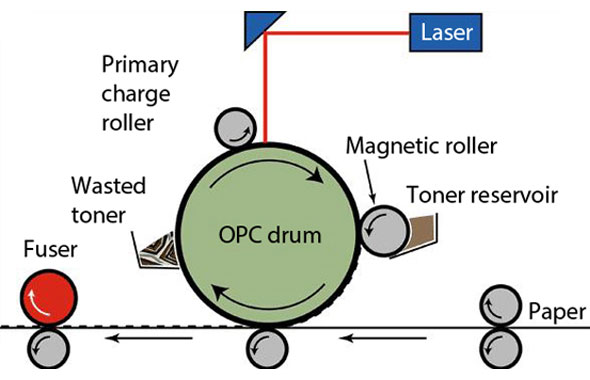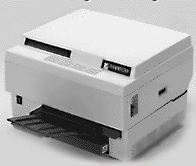Before speaking about the history of laser printers, I need to explain the basis of this technology.
The main thing in laser printing is static electricity that attracts objects of opposite charges one to another. The printer uses this effect as a special glue of a temporary action. The main part of the printing unit is a photoreceptor – rotating cylinder (drum) coated with photoconductive material that is discharged by photons. First the drum is charged with positive charge by the primary corona wire. While rotating, the drum is fired by a laser that discharges particular areas of the surface, thus drawing the grid of required letters and images. When the grid is done the drum is coated with positively charged toner that is attracted only to discharged areas of the drum. After that, the paper is negatively charged by another corona wire and rolled against the toner covered drum. This charge surpasses the negative charge of the grid and that’s why the toner is attracted to the paper thus forming an image. After the toner is attracted, the paper is charged by the third corona wire for the paper not to stick to the drum. After that the paper is fed to the fuser – a couple of heated rollers. When in fuser assembly, the toner is melted and imprinted into the paper grain. After that your print reaches the tray. After developing, the surface of the drum is discharged by the discharge lamp so any residual electrostatic charge is removed. The drum then gets new positive charge from the corona wire and the process starts all over again.

And now let’s get to the days gone by. If the history of ink-jet printing is filled with science, researches and discoveries, than laser printing evolution has more of a businesslike trend and more related to the marketing rather than science.
In 1938, student of law Chester Carlson received his first xerographic image as a result of many years of his work that have begun due to his dissatisfaction with the low speed of mimeographs existed and the high imprint prices. The “xerography” notion itself derives from Greek words “dry” and “to write”. And the point of the new technology was using static electricity to transfer dry ink (toner) onto the paper.
However, only in 8 years, rejected by IBM and even by Signal Corps, in 1946 Carlson finds a company that agrees to manufacture invented electrostatic copiers. It was Haloid Company that later turned into well known Xerox Corporation.
Back in 1949, the very first Xerox device on the market was so-called Model A. It was quite a huge and complex device. To get a copy of the document out of it, one had to perform a number of operations. And only a decade later, the first fully automated xerographic recorder was commercialized. It was Xerox 914, able to print 7 copies per minute. This model become a prototype of all copiers and laser printers brought afterwards.

Xerox started to develop laser printers in 1969. Success arrived in 1978 when corporate employee Gary Starkweather have managed to add a laser beam to already existing Xerox technologies, thus he have invented a laser printer. Full duplex Xerox 9700 is able to print 120 pages per minute (and that is still the world fastest laser printer). However, the device was enormously huge and the price of 350 thousand dollars wasn’t quite meeting the idea of “printer for everyone”.

In early 80th demand for devices that were superior to already existing matrix printers as to the quality of printing, have reached a critical level. In 1982 Canon came up with a supply and presented a first desktop printer LBP-10. Next year the company had privately presented a new LBP-CX model to Californian Apple, Diablo and HP.
At that moment Canon required strong partners for marketing their production on a market that was whole new to the company. The company was strong in cameras and office solutions (copiers) area of production, yet still having no connections needed for effective sales on the data-processing units market. First, Canon went to Diablo Systems, the subdivision of Xerox Corporation. It was an obvious thing to do, since Diablo held the most part of daisy wheel printer market, and Diablo marketing experts were willing to place their logo on other brands production. Hence, Xerox was the first company offered to market the CX system with Canon controller.
Nevertheless, Xerox gave thumbs-down on this offer, since along with Japanese Fuji-Xerox it was developing a device that was planned to be the best desktop laser printer on the market. Even though the new 4045 model was both copier and laser printer, it weighed around 50 kilos, was two times as expensive as CX, had no replaceable toner cartridge and allowed not the best printing quality. Later on, former Diablo marketing experts accepted the fact that it was a huge mistake to neglect the proposal from Canon, and that HP LaserJet that came later on could have easily been Xerox LaserJet.
Anyway, after having been rejected by Diablo in Fremont, Canon drove a few miles more and visited HP in Palo Alto and Apple Computer in Cupertino. Hewlett-Packard was the second reasonable choice, since it was working in close rapport with Diablo and had quite a wide ranges of matrix and daisy-wheel printers.


In 1984, the collaboration of HP and Canon resulted in production of LaserJet printers that were printing 8 pages per minute. Sales were growing rather quickly and it led to Hewlett-Packard mastering the market of desktop laser printers in 1985. Bear in mind that as in the case with ink-jet printers, new devices become widely available only after replaceable toner cartridges were designed (in this case the creator is Hewlett-Packard).
And due to that, problems of cheapening new and recycling old cartridges, the number of which started to imply about ecology problems, gave birth to the whole new branch of processing industry in 1986.
P.S.
What is waiting for us? Perhaps, only the time will answer this question. Predictions and fortune-telling is thankless occupation. I don’t think that in the foreseeable future we will see something revolutionary and different from what we already have. These days, all of the technologies are at the peak level, and so, manufacturers continue to polish and pack their devices with unusual for modern printers optional functions and features. So, what we can do now is if not to be sitting and doing nothing, than just to be on the outlook for forthcoming, even more modern and hi-end models.
Adapted from http://www.ixbt.com/